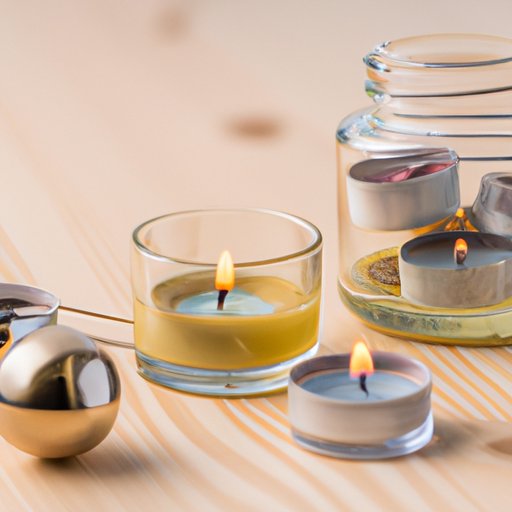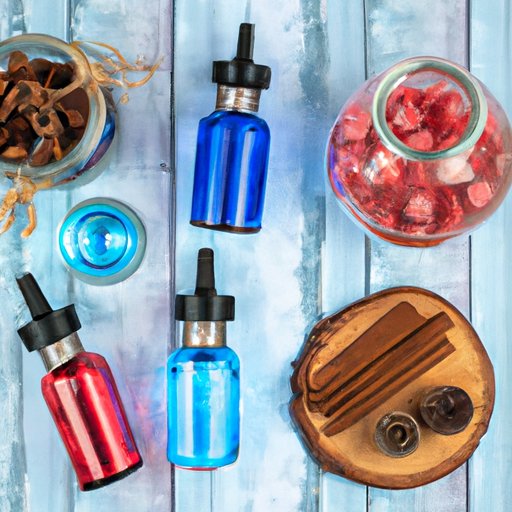Introduction
Aromatherapy has gained immense popularity over the past decade, with the beauty and wellness industry endorsing its effectiveness. One of the key components of aromatherapy is an essential oil diffuser. They are durable, lightweight, and easy to use and can improve overall wellness by filling the air with fragrant and healing essential oils. This article aims to provide a detailed overview of aromatherapy diffusers and their benefits, so you can make an informed decision about which type suits you best.
Everything You Need to Know About Aromatherapy Diffusers
What is aromatherapy?
Before diving into aromatherapy diffusers, it is essential to understand what aromatherapy is. Aromatherapy is a form of alternative medicine that uses essential oils to promote physical and emotional wellness. Essential oils are extracted from plants, and each oil has a unique fragrance and healing properties.
How does a diffuser work?
Diffusers release essential oils into the air through a fine mist. The mist is created by ultrasonic vibrations or heat. The mechanism used to create the mist varies based on the type of diffuser.
Types of aromatherapy diffusers available in the market
There are several types of aromatherapy diffusers available in the market. Here are the most popular ones:
- Ultrasonic diffusers: These diffusers use ultrasonic vibrations to break the essential oil particles into a fine mist. They also have the added benefit of humidifying the air.
- Heat diffusers: These diffusers use heat to release the essential oil molecules into the air. They are simple, affordable, and require no electricity, but they can break down the therapeutic compounds in essential oils.
- Nebulizing diffusers: These diffusers break the essential oils into tiny particles that fan out into the room. They are incredibly powerful and require no heat, water or carrier oils. They simply use air pressure to diffuse the oils.
- Evaporative diffusers: These diffusers use a fan to blow air over a pad or filter, which has the essential oil drops on it. The air blowing over the pad then evaporates the oil and releases it into the surrounding air.
How to use an aromatherapy diffuser effectively for best results
To use an aromatherapy diffuser, add water to the unit, then add a few drops of your favorite essential oil to the water. Depending on the diffuser mechanism and the brand, the number of drops needed may vary. Once the essential oil is added to the water, turn on the diffuser and enjoy the fragrance. Make sure the diffuser is placed in a well-ventilated area, away from any open flames and pets.
How to Choose The Best Diffuser for Your Specific Needs
Factors to consider when choosing an aromatherapy diffuser
Choosing the perfect aromatherapy diffuser depends on your personal needs and the space in which you want to use it. When selecting an aromatherapy diffuser, consider the following factors:
- Room size: Select a diffuser that suits the space you intend to use it in. Larger rooms require larger diffusers, and vice versa.
- Water capacity: If you want a diffuser that runs for a long time, choose one with a larger water capacity.
- Run time: Most diffusers have between 3-4 hours of continuous run time. If you’re looking for a diffuser that lasts longer, choose one with a longer run time.
- Diffuser style and design: Aromatherapy diffusers come in various designs, including ultrasonic diffusers, nebulizers, and diffuser with ambient lighting. Choose one that fits your style and aesthetic.
- Price point: Diffusers come in various price points, but it’s important to choose a product that suits your budget.
Understanding the difference between the various types of diffusers
The type of diffuser you choose depends on your preference and space. If you have a small space, an ultrasonic or an evaporative diffuser will work best. If you want a powerful and therapeutic diffuser, then a nebulizing diffuser will do the trick. A heat diffuser is ideal for those who want something simple and cheap.
Budget considerations
Aromatherapy diffusers range from affordable to expensive. While it’s crucial to choose a diffuser that caters to your personal needs, it’s equally vital to select one that fits your budget. Prices range from $15 for basic diffusers to $150 for high-end models.
Benefits of Using a Diffuser for Your Health and Well-being
Improved sleep quality
Aromatherapy diffusers can help improve sleep quality as the fragrances emitted calm the mind and promote relaxation. Scents like lavender, chamomile, and mandarin are best for promoting restful sleep.
Stress relief and anxiety reduction
Aromatherapy diffusers can help reduce stress and anxiety by relaxing the mind and body. Scents like frankincense, peppermint, and ylang-ylang can soothe the nerves and promote calmness.
Improved cognitive function
Essential oils like rosemary, peppermint, and eucalyptus are known to help improve cognitive function and memory retention. Using a diffuser with these oils can boost concentration and focus.
Enhances mood and productivity
Aromatherapy diffusers can also help set the mood in your home or office and enhance productivity. Scents like citrus, bergamot, and lemongrass promote positivity, energy, and focus.
Other benefits
Other benefits of aromatherapy diffusers include relieving respiratory issues, reducing headaches, and repelling insects.
DIY Aromatherapy Diffuser Blends to Elevate Your Mood
Overview of DIY diffuser blends
DIY essential oil blends can help elevate your mood, promote relaxation, improve focus, and even boost energy levels. The recipes are easy to follow and customize based on personal preferences.
Easy to follow recipes for different moods
Here are some of the most popular DIY essential oil blends to try at home:
- Relaxation blend: lavender, bergamot, and cedarwood
- Focus blend: rosemary, lemon, and peppermint
- Energy blend: grapefruit, peppermint, and cinnamon
- Mood-lifting blend: sweet orange, ylang-ylang, and patchouli

From Candles to Diffusers: The Evolution of Home Fragrance
History of home fragrance
Home fragrance has been a part of human history for centuries. Ancient Egyptians used incense, and Native Americans burned sage to purify the air. It wasn’t until the 18th century that candles became widespread in the Western world.
How diffusers have replaced traditional home fragrance methods
In recent years, aromatherapy diffusers have become popular and have replaced traditional home fragrance methods like candles and air fresheners. While candles and air fresheners can be toxic, diffusers use only natural essential oils, making them a healthier option.
An overview of the benefits of using diffusers over other home fragrance methods
Diffusers not only purify the air and eliminate bad odors, but they also offer therapeutic benefits with their essential oils. Unlike candles and air fresheners, diffusers do not produce smoke or unwanted chemicals, making them a safer option.
The Science Behind Essential Oil Diffusion and Its Effects on the Brain
How essential oil diffusion affects the brain
When essential oils are diffused into the air, they enter the body through the nose and lungs, making their way to the limbic system in the brain. The limbic system controls emotions and memories, and inhaling essential oils can have a therapeutic effect on the brain.
The role of olfactory stimulation in essential oil diffusion
The olfactory system is responsible for processing smells, and the limbic system processes the emotional response to scents. Inhaling essential oils can stimulate both systems, making aromatherapy an effective way to promote relaxation, focus, and many other benefits.
Scientific research on essential oil diffusion and brain function
Several scientific studies have been conducted to research the therapeutic benefits of essential oils, including their effect on the brain. One study found that inhaling lemon oil can help improve mood, while another showed that lavender oil can reduce anxiety, stress, and promote better sleep quality. Overall, there is evidence to support the use of aromatherapy for improved well-being.
Exploring The Different Types of Essential Oil Diffusers and Their Features
In-depth look at the different types of essential oil diffusers
Here is an in-depth look at the different types of essential oil diffusers:
- Ultrasonic diffusers: They are easy to use and require no heat, making them the most popular. They also double as a humidifier, adding moisture to the air.
- Heat diffusers: These diffusers require heat to diffuse the oils and may not be the best option for those who want to keep the therapeutic properties of the oils intact.
- Nebulizing diffusers: This is the most potent diffuser as it does not use any water or heat, ensuring that the essential oils retain their therapeutic properties. However, they can be expensive and loud.
- Evaporative diffusers: These diffusers require no water or heat and are ideal for those who want a simple, affordable option.
Features and benefits of different types of diffusers
Essential oil diffusers differ based on their features and benefits. Ultrasonic diffusers have a humidifying function, while heat diffusers are budget-friendly. Nebulizing diffusers are potent but expensive, and evaporative diffusers are ideal for those who want a simple option that doesn’t require electricity or water.
Which diffuser suits which type of user
The diffuser that suits you best depends on your personal preferences. If you want a potent diffuser that is quiet and requires no heat, then go for a nebulizing diffuser. However, if you want a budget-friendly option, then choose a heat diffuser. Ultrasonic diffusers are ideal for those who want a long-lasting option that can double as a humidifier.
Conclusion
Aromatherapy diffusers offer a simple and effective way to promote physical and emotional well-being. There are several types to choose from, and each has its benefits and features. By understanding the different types of diffusers available, it’s easier to select one that caters to your personal needs. Remember to choose essential oils that work best for your specific goals and intentions, and diffuse them in a well-ventilated space to maximize their benefits.
